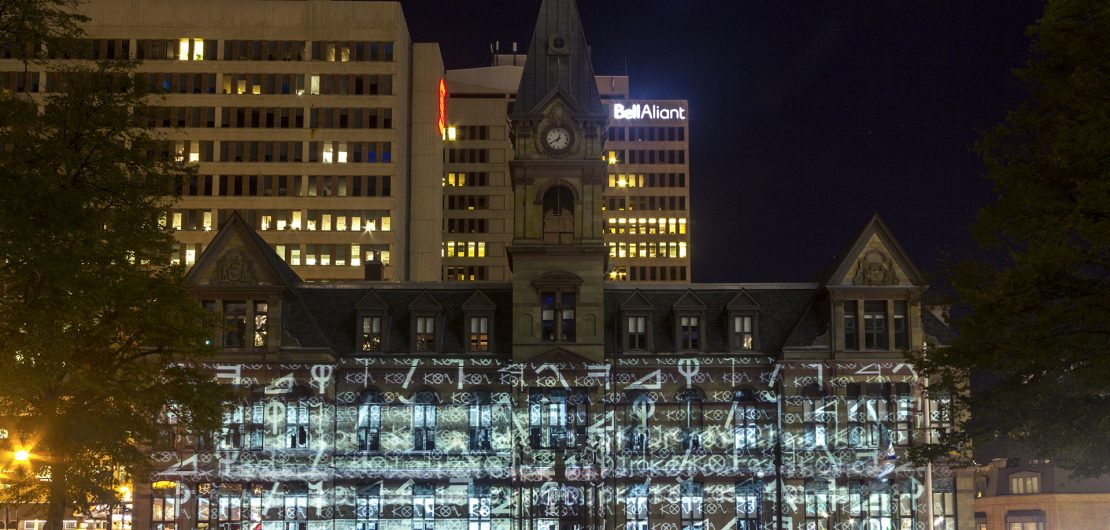
joeressen+kessner is one of the participating artists’ teams in the first edition of //RESPONSIVE International Light Art Project Halifax. Their work can be seen at Halifax City Hall.
//joeressen+kessner engender site-specific interventions that allow to perceive, to understand and to categorize a site in a new quality. Preferred, they work with historically charged sites to which they respond with transmedia interventions. Their works are digitals systems that interfere with the analog status quo via image and sound applications. They generate data systems that control audiovisual projections which are applied in real-time to a chosen environment. Their transmedia compositions are based on dialogic principles ranging from between the two artists, between to two spheres “audio” and “visual”, between analog and digital architecture, between light and sound waves, between the material and immaterial dimension.
In their research on a site, they cover architectural concepts and structures, emblematic qualities and acoustic patterns. They ponder on function and use, history and memory, experiences and associations as well as culture-historical, scientific or theoretical aspects. The process of exploring and developing constantly shifts between concrete and universal, specific and fundamental, practice and theory. They collect and sort, reflect and experiment with their finding to develop a semantic map that serves as the foundation of their compositions.
In the development process, joeressen+kessner focus on the transition of how coding content leads to a character, on how the hosting medium influences the appearance and on how space and time alter a digital figuration – in general as well as on the site in particular. They consider a character an abstract unit where a formative framework and associated meaning, significance and representation are in constant, reciprocal negotiation. They develop set of characters as an artistic system of that allow expression, that can be read as a language, and that allow hosting knowledge in a new way. Their works come as digital character sets that drive image and sound projections that interfere with the appearance of the space. Their encodings instruct self-organizing processes, and these develop as autonomous patterns in which the intentional and the non-intentional engender a performative play. This leads to rhizome of influences that are too complex to be fully analyzed and which can only be understood by extended observation of the interaction. The unpredictable part of this approach links to them to artistic approaches based on generative processing but to ensure their artistic autonomy, joeressen+kessner work without pre-programmed standards as well as without any form of presets and plug-ins.
They form a network of interconnected paths and tracks which overlap each other and branch out repeatedly as a real-time environment. Unlike image systems as known from film, video, and animation which are generated separately, illuminated, reckoned, reworked and cut before they are broadcasted, real-time processing is a high performative system in which rendering and display coincide and which reinvent itself while performing. By coding open systems, a continuous change between analysis, instruction, and expression takes place. The traditional separation between development, production, and performance is abolished and notation, recording and display are modulated in real time. Complexity, incomprehensibility, and incompleteness are part of this kind of artistic research. The formatting of these processes is the composition process of joeressen+kessner.
The implementation of the digital dimension in an analog space via projection allows to disintegrate found settings and limitations and permits a redesign of references, reference sets, and reference qualities. The physical space with its architectural, spatial and temporal ratios turns into a media system. Light as primary media of the analog sphere and as the media of display of the digital sphere serves as the interface and permits the linkage.
With their transmedia interventions, joeressen+kessner further a development that altered the canon of fine arts in the middle of the 20th century. The first electronic-spatial environment that combines architecture, film, light, and music into a fusion of space and time is the Philips-Pavilion, that was realized 1958 in Brussels. The artistic direction was at Le Corbusier in co-operation with Iannis Xenakis and Edgard Varèse. Compositions of acoustic space and architecture, light behavior and image generation, aesthetic qualities and perception properties and digital technologies led to new synthesis. Golo Föllmer describes the Philips Pavilion: “Two tape compositions were created for this: “Poème électronique” by Edgard Varèse which aimed at an intensive fusion of space and sound experience. The used synthetic and concrete sounds were shown to Le Corbusier ‘s film or light projection with the help of elaborate loudspeaker technology as lines and volumes in the space.” In the 21st century, the transmedia interplay was expanded by generative data systems by artists like joeressen+kessner.
Since 2001, Eva-Maria Joeressen and Klaus Kessner have been working together developing transmedia compositions as spatial interventions. Both are professional artists since the 1980s and both are active teachers: Klaus Kessner has been visiting lecturer at University of Applied Sciences Duesseldorf and the Peter-Behrens-School of Arts and Eva-Maria Joeressen holds a professorship at the Peter-Behrens-School of Arts in Duesseldorf. In addition, she is involved in the German “Light in Fine Arts [LIFA]” – network to strengthen research and discourse on light in fine arts in higher educations.
[Text: Bettina Pelz]